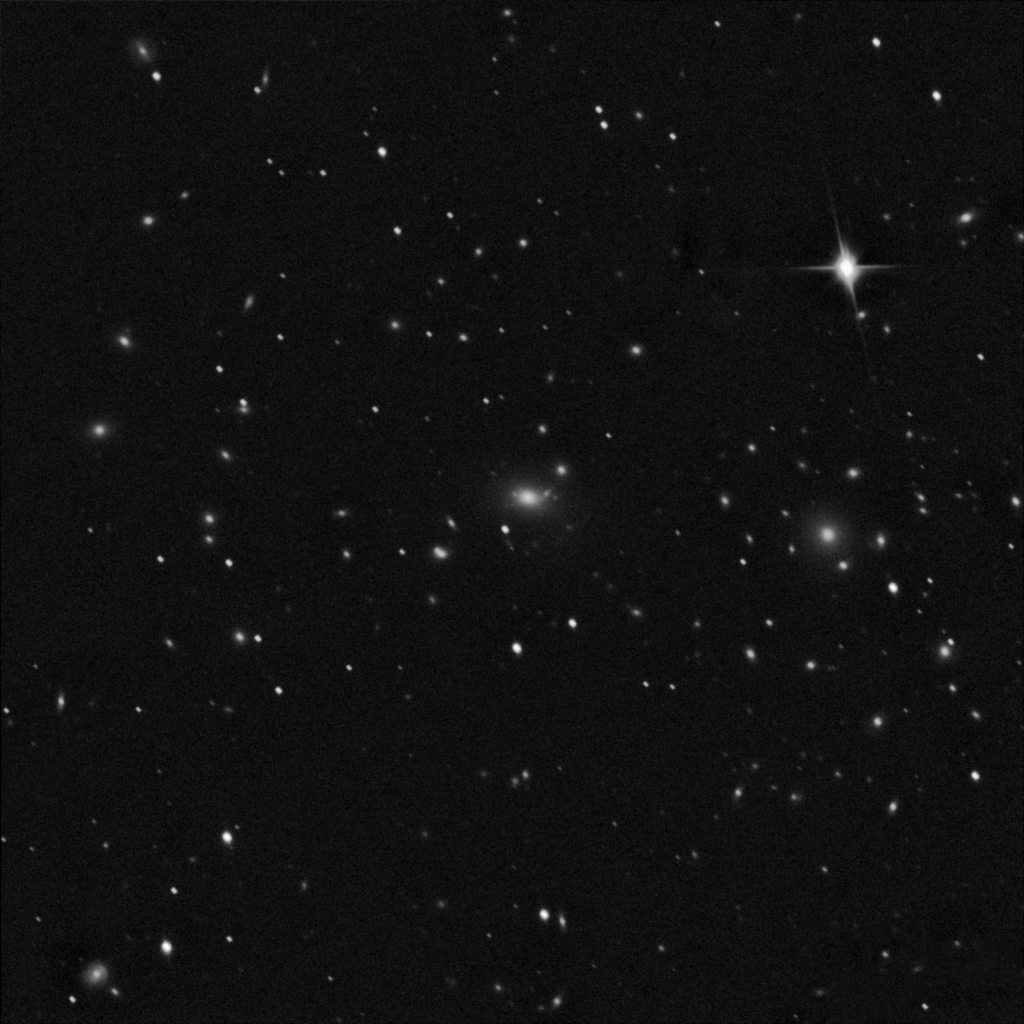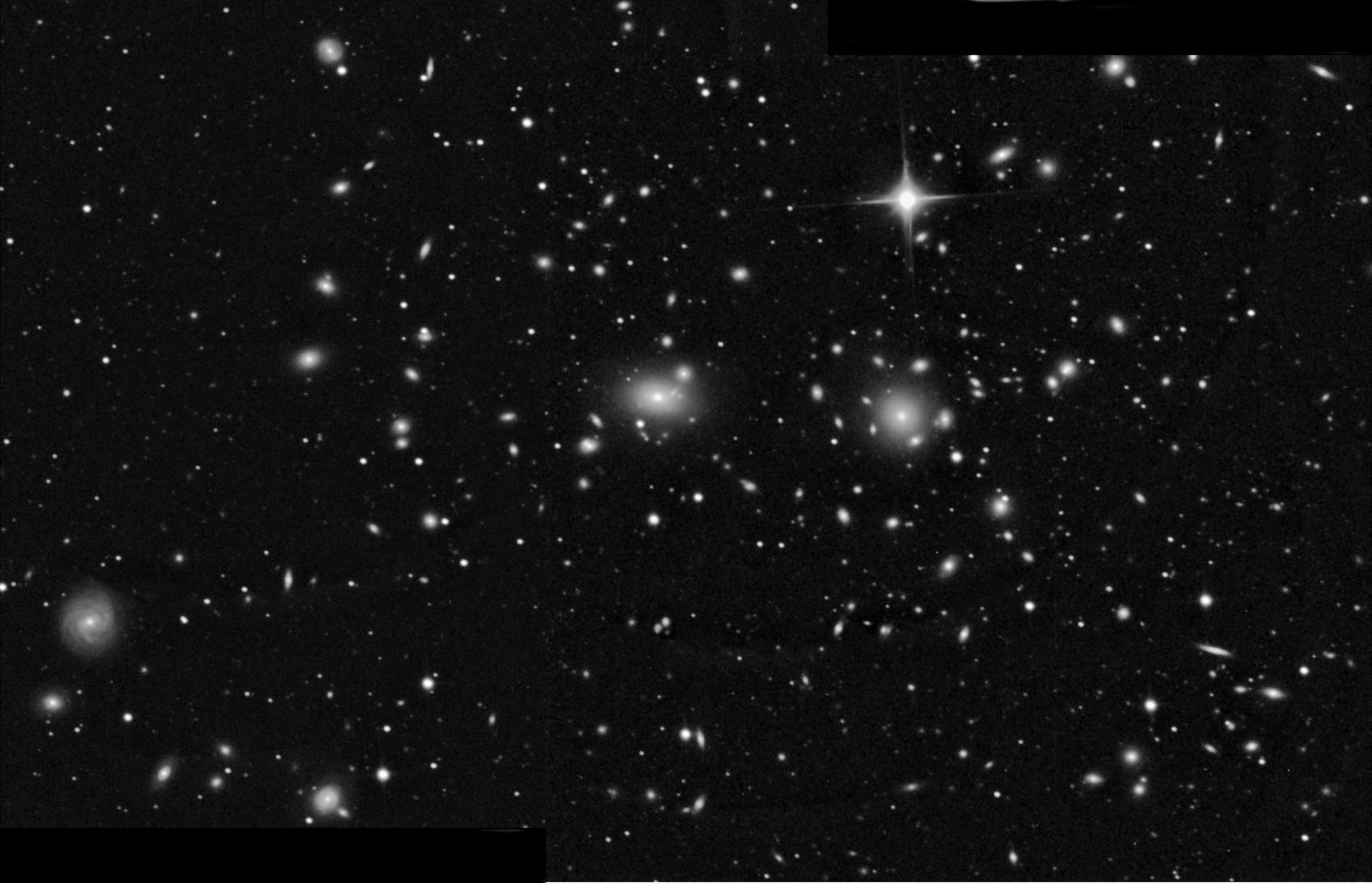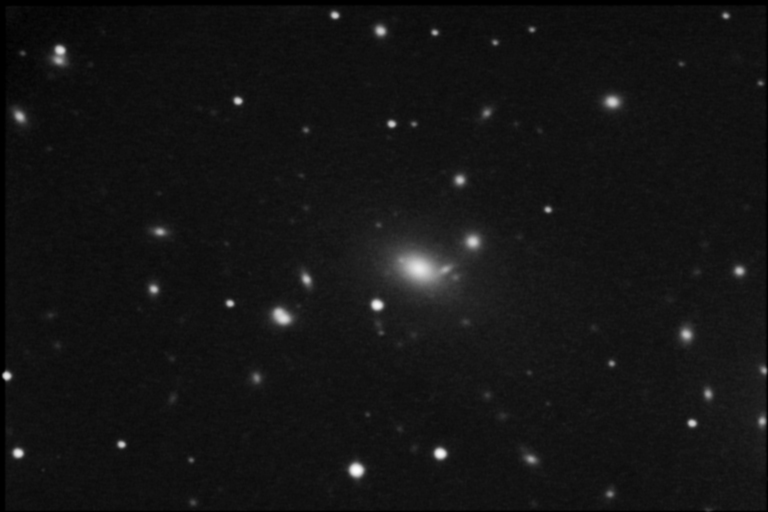
Combination of 4, 3 minute images.
Meade 416XTE CCD. 300mm f/6 newtonian telescope at prime focus.

Almost all observers are well aware of then Virgo cluster of galaxies. That huge swarm of over 1000 galaxies that straddles the Coma Berenices-Virgo region. However not so well known is that there is another equally large cluster in Coma Berenices known as The Coma Cluster or Abell Galaxy Cluster 1556. The main reason that this galaxy cluster is not so well known is that the cluster is nearly 10 times further away than the Virgo cluster, at a distance of over 400 million light years. This means that most of the members of the cluster are small and faint.
The brightest member is the giant eliptical galaxy NGC 4889. At magnitude 13, it is about the most distant galaxy visible in a small telescope, having been observed in telescopes as small a 5". Within 1.5 degrees of the centre of the cluster there are over 800 galaxies brighter than magnitude 16.5. While undoubtably many of these are background galaxies, the cluster is nontheless very rich.
Below are several maps to assist observers in locating this very distant object. The first map is a large scale map showing the general area around the cluster. The second chart shows an area of about 4 degrees and includes the cluster and the nearest bright star, beta comae. This is for use at the finder. The final charts are small-scale maps of the cluster showing ever fainter stars and is for use with the main telescope. The numbers alongside some of the stars are the magnitudes of those stars.
The photograph above shows the region around NGC 4889. Even this small region (about 13' x 8') there are more than 25 galaxies visible. Compare this image with the last chart. In the image NGC 4874 is just out of view on the right. The numbers alongside many of the galaxies are the number of the galaxy in the list below.

|

|

|

|
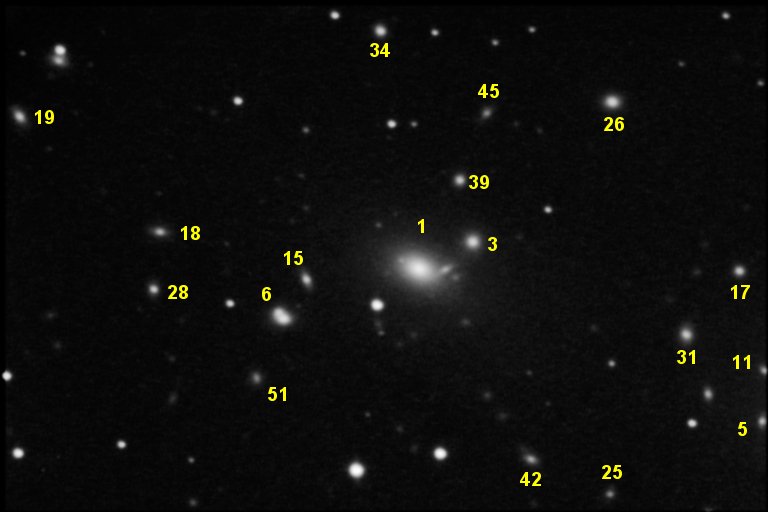
Below is a list of many of the galaxies shown in the above image and on the last map. This list gives the name of the galaxy, its position, magnitude, and size. Many of the fainter magnitudes are photographic and will appear brighter to the eye. How many objects from this list can you locate?
|
|
|
|
|
|
|
|
|
|
NGC 4889 | PGC 44715 | 13 00 08.1 | +27 58 36 | 12.5 | 2.8'x2.2' |
|
|
NGC 4874 | PGC 44628 | 12 59 35.7 | +27 57 33 | 12.6 | 2.3'x2.3' |
|
|
NGC 4886 | PGC 44698 | 13 00 04.5 | +27 59 15 | 13.8 | 0.6'x0.6' |
|
|
IC 4051 | PGC 44832 | 13 00 54.5 | +28 00 27 | 14.2 | 1.0'x08' |
|
|
PGC 44644 | 12 59 39.7 | +27 57 13 | 14.4 | 0.4'x0.2' | |
|
|
NGC 4898 | PGC 44736 | 13 00 17.8 | +27 57 19 | 14.5 | 0.5'x0.5' |
|
|
NGC 4864 | PGC 44566 | 12 59 13.2 | +27 58 35 | 14.6 | 0.7'x0.7' |
|
|
NGC 4865 | PGC 44578 | 12 59 19.9 | +28 05 03 | 14.6 | 0.9'x0.5' |
|
|
NGC 4908 | PGC 44828 | 13 00 51.6 | +28 02 33 | 14.7 | 0.8'x0.6' |
|
|
NGC 4869 | PGC 44587 | 12 59 23.4 | +27 54 41 | 14.8 | 0.7'x0.7' |
|
|
PGC 44636 | 12 59 39.0 | +27 59 10 | 14.8 | 0.4'x0.3' | |
|
|
IC 4045 | PGC 44818 | 13 00 48.7 | +28 05 26 | 15.0 | 0.7'x0.4' |
|
|
NGC 4873 | PGC 44621 | 12 59 32.8 | +27 59 00 | 15.1 | 0.7'x0.5' |
|
|
NGC 4906 | PGC 44799 | 13 00 39.8 | +27 55 25 | 15.1 | 0.5'x0.5' |
|
|
NGC 4894 | PGC 44732 | 13 00 16.5 | +27 58 02 | 15.1 | 0.6'x0.3' |
|
|
NGC 4871 | PGC 44606 | 12 59 30.0 | +27 57 21 | 15.2 | 0.7'x0.5' |
|
|
PGC 44656 | 12 59 43.7 | +27 09 40 | 15.2 | 0.4'x0.4' | |
|
|
PGC 44771 | 13 00 28.4 | +27 58 20 | 15.2 | 0.6'x0.3' | |
|
|
IC 4041 | PGC 44804 | 13 00 40.9 | +27 59 47 | 15.3 | 0.5'x0.3' |
|
|
IC 4042 | PGC 44808 | 13 00 42.8 | +27 58 16 | 15.3 | 0.7'x0.5' |
|
|
IC 3973 | PGC 44612 | 12 59 30.8 | +27 53 02 | 15.4 | 0.8'x0.5' |
|
|
IC 4040 | PGC 44789 | 13 00 37.9 | +28 03 26 | 15.4 | 1.0'x0.3' |
|
|
NGC 4867 | PGC 44568 | 12 59 15.3 | +27 58 14 | 15.4 | 0.6'x0.5' |
|
|
NGC 4872 | PGC 44624 | 12 59 34.1 | +27 56 48 | 15.4 | 0.6'x0.4' |
|
|
NGC 4876 | PGC 44658 | 12 59 44.4 | +27 54 44 | 15.4 | 0.6'x0.4' |
|
|
NGC 4883 | PGC 44682 | 12 59 56.0 | +28 02 04 | 15.4 | 0.6'x0.4' |
|
|
PGC 44581 | 12 59 20.2 | +27 53 09 | 15.4 | 0.5'x0.3' | |
|
|
PGC 44763 | 13 00 28.0 | +27 57 21 | 15.4 | 0.5'x0.3' | |
|
|
PGC 44575 | 12 59 13.9 | +28 04 34 | 15.6 | 0.7'x0.7' | |
|
|
IC 4026 | PGC 44749 | 13 00 22.1 | +28 02 48 | 15.6 | 0.6'x0.5' |
|
|
IC 3998 | PGC 44664 | 12 59 46.9 | +27 58 25 | 15.6 | 0.6'x0.4' |
|
|
PGC 44849 | 13 00 59.3 | +27 53 59 | 15.6 | 0.7'x0.3' | |
|
|
NGC 4875 | PGC 44640 | 12 59 37.9 | +27 54 26 | 15.7 | 0.5'x0.4' |
|
|
IC 4021 | PGC 44726 | 13 00 14.8 | +28 02 28 | 15.9 | 0.4' |
|
|
PGC 44616 | 12 59 31.5 | +28 02 47 | 15.9 | 0.8'x0.3' | |
|
|
PGC 44716 | 13 00 09.1 | +27 51 58 | 16.0 | 0.3'x0.2' | |
|
|
IC 4012 | PGC 44714 | 13 00 08.0 | +28 04 42 | 16.0 | 0.4'x0.3' |
|
|
PGC 44662 | 12 59 40.9 | +27 51 14 | 16.0 | 0.3'x0.2' | |
|
|
IC 4011 | PGC 44705 | 13 00 06.4 | +28 00 14 | 16.1 | 0.4' |
|
|
PGC 44585 | 12 59 22.6 | +27 53 48 | 16.3 | 0.5'x0.3' | |
|
|
PGC 44809 | 13 00 42.9 | +27 57 47 | 16.3 | 0.5'x0.3' | |
|
|
PGC 44675 | 12 59 56.7 | +27 55 47 | 16.4 | 0.6'x0.3' | |
|
|
PGC 44723 | 13 00 12.9 | +28 04 31 | 16.4 | 0.5'x0.3' | |
|
|
PGC 44602 | 12 59 28.7 | +28 02 25 | 16.5 | 0.5'x0.3' | |
|
|
PGC 44707 | 13 00 06.1 | +28 01 23 | 16.5 | 0.6'x0.3' | |
|
|
PGC 44740 | 13 00 16.6 | +28 03 47 | 16.5 | 0.5'x0.3' | |
|
|
PGC 44815 | 13 00 44.6 | +28 06 01 | 16.5 | 0.4'x0.1' | |
|
|
PGC 44594 | 12 59 26.4 | +27 59 53 | 16.6 | 0.3'x0.2' | |
|
|
PGC 44649 | 12 59 42.3 | +27 55 28 | 16.6 | 0.3' | |
|
|
PGC 44597 | 12 59 25.3 | +27 58 04 | 16.7 | 0.4'x0.2' | |
|
|
PGC 44741 | 13 00 18.2 | +27 56 12 | 16.7 | 0.4' |
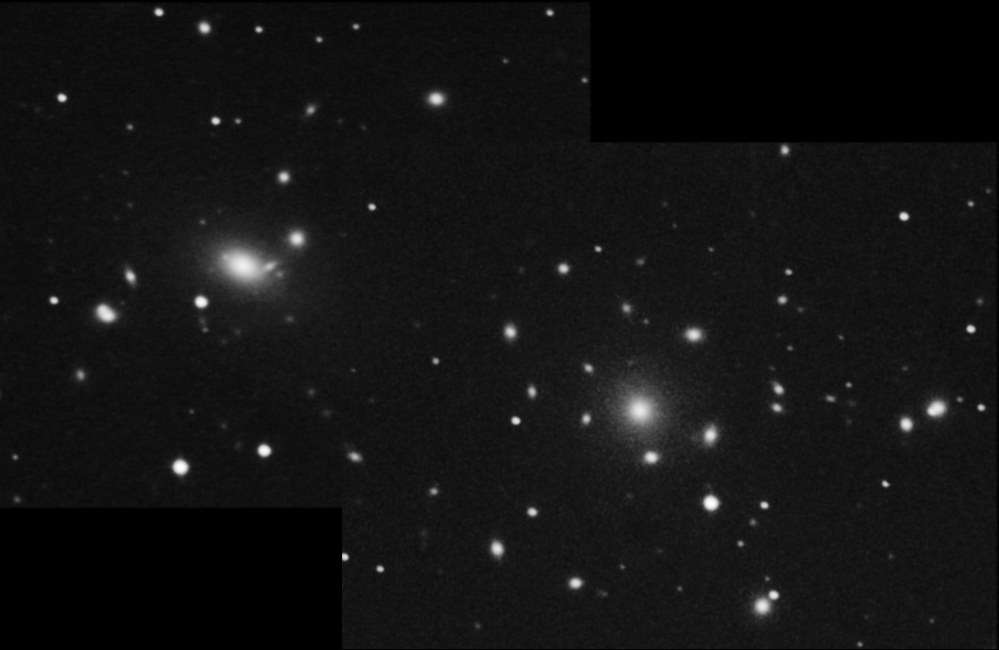
Mosiac of the Coma cluster. Each image is a combination of 4, 3 minute exposures.
Meade 416XTE CCD. 300mm f/6 newtonian at prime focus.
